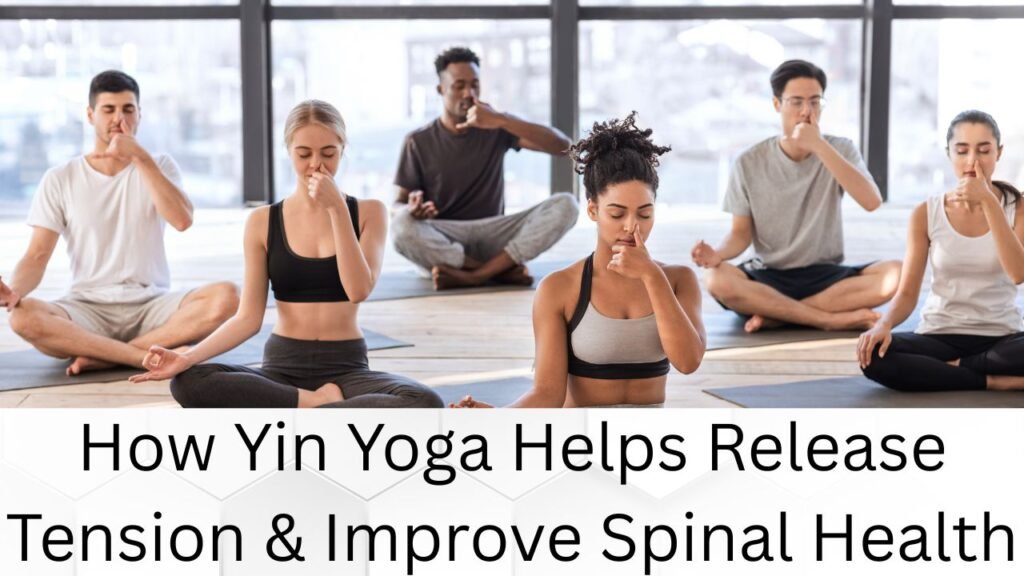The spine is the foundation of movement and posture. Yet, modern lifestyles filled with prolonged sitting, poor posture, and stress lead to spinal stiffness, pain, and tension. Yin Yoga offers a slow, meditative approach to counter these issues, providing deep tissue release and improved spinal health. By holding poses for extended periods, Yin Yoga works on the connective tissues, joints, and fascia, making it a powerful tool for spinal well-being.

Understanding Yin Yoga & Its Impact on the Spine
Unlike dynamic forms of yoga, Yin Yoga focuses on long-held, passive stretches. It targets deep connective tissues, including ligaments, fascia, and joints, promoting flexibility and mobility. This practice is particularly beneficial for the spine, as it helps release stored tension and hydrates intervertebral discs, reducing stiffness and discomfort.
Yin Yoga also activates the parasympathetic nervous system, encouraging relaxation and reducing stress-related muscle tightness. By allowing gravity to do the work, the practice helps decompress the spine naturally, leading to long-term relief from chronic pain and discomfort.
Key Benefits of Yin Yoga for Spinal Health
1. Releases Deep-Seated Tension
Spinal tightness often results from accumulated tension in the surrounding muscles and fascia. Yin Yoga stretches these areas, breaking up adhesions and restoring fluid movement to the spine. Long holds allow connective tissues to soften, leading to lasting relief.
2. Improves Spinal Flexibility & Mobility
A flexible spine is essential for preventing injuries and maintaining overall mobility. Yin poses gently elongate the spine, increasing its range of motion. This reduces the risk of stiffness, which often leads to back pain.
3. Enhances Circulation & Disc Hydration
Intervertebral discs require movement and hydration to stay healthy. Yin Yoga promotes gentle compression and decompression of these discs, improving circulation and nutrient flow. This keeps the spine supple and resilient.
4. Supports Postural Alignment
Poor posture contributes to chronic back pain and spinal misalignment. Yin Yoga counteracts this by targeting imbalances in the connective tissues, particularly in the lower back, shoulders, and neck. This leads to a more upright and natural posture.
5. Reduces Stress & Encourages Relaxation
Stress and anxiety contribute to muscle tension, particularly in the upper back and shoulders. Yin Yoga activates the body’s relaxation response, lowering cortisol levels and helping the nervous system shift into a restful state. This reduces overall tension and improves sleep quality.
Best Yin Yoga Poses for Spinal Health
1. Caterpillar Pose (Seated Forward Fold)
Targets: Spine, hamstrings, lower back
- Sit with legs extended forward and relax the upper body over the thighs.
- Hold for 3-5 minutes while breathing deeply.
- This pose decompresses the lower back and improves spinal flexibility.
2. Sphinx Pose
Targets: Lower back, spine, chest
- Lie on your stomach and prop yourself up on your forearms.
- Keep elbows under shoulders, lifting the chest while keeping the spine elongated.
- Hold for 3 minutes to gently strengthen the lower back and improve posture.
3. Dragon Pose
Targets: Hips, lower back, psoas
- Step one foot forward into a deep lunge, keeping the back leg extended.
- Hold for 3 minutes per side to release hip tension and relieve lower back tightness.
4. Butterfly Pose
Targets: Lower spine, hips, inner thighs
- Sit with soles of the feet together, allowing the knees to drop open.
- Lean forward slightly and relax into the stretch for 3-5 minutes.
- This releases tension in the lower spine and enhances hip mobility.
5. Reclining Twist
Targets: Spine, lower back, obliques
- Lie on your back and bring one knee across the body into a gentle twist.
- Keep both shoulders grounded and hold for 3 minutes per side.
- This improves spinal mobility and releases tightness in the lower back.
Tips for Practicing Yin Yoga Safely
- Move Slowly & Mindfully: Unlike active yoga styles, Yin Yoga requires patience. Ease into each pose and avoid forcing movement.
- Use Props: Blocks, bolsters, and blankets can support the body, making poses more accessible and comfortable.
- Breathe Deeply: Slow, controlled breathing helps deepen stretches and activate the relaxation response.
- Stay Still: Holding each pose for 3-5 minutes allows tissues to release gradually, enhancing effectiveness.
- Practice Consistently: Regular practice (3-4 times per week) yields the best results for spinal flexibility and tension release.
Final Thoughts
Yin Yoga is a gentle yet powerful way to support spinal health. By targeting deep connective tissues and encouraging relaxation, it releases tension, enhances flexibility, and promotes better posture. Whether dealing with chronic back pain or seeking preventive care, incorporating Yin Yoga into your routine can lead to lasting spinal relief.
Start slowly, listen to your body, and embrace the stillness. Over time, you’ll notice a more supple, pain-free spine and an overall sense of well-being.